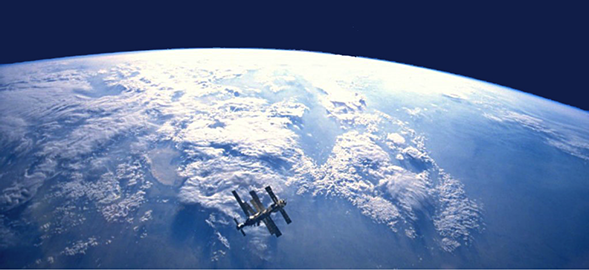-
WHAT IS NASA PHYSICS?
-
MODULES
-
Forces and Motion
-
Conservation of Momentum & Energy
-
Temperature and Heat
-
Fluids
-
Optics
-
Electromagnetic Spectrum
-
Modern Physics
-
Anticipation Guide 7
-
Intro to Modern Physics
-
Blackbody Radiation
-
The Ultraviolet Catastrophe
-
The Photoelectric Effect
-
Bohr's Atom
-
Spectra
-
Radioactive Decay
-
Special Relativity (SR)
-
Simultaneity
-
Distance and Time
-
General Relativity
-
May the Forces be with You
-
Modern Physics Notebook
-
Assessment Problems 7
-
-
Useful Things
-
-
SITE MAP
Forces and Motion
-
Anticipation Guide
-
Speed and Velocity
-
Acceleration
-
Gravity
-
Projectile Motion
-
Orbital Motion
-
Newton's Laws of Motion
-
Assessment Problems
Orbital Motion
Description
International Space Station orbiting earth in 1995. Photo from NASA. Newton realized that if the Earth were spherical, except for mountains, a cannon ball shot with a high enough velocity would constantly fall towards the ground but never hit it, because of the curvature of the Earth. This is the basis for launching a satellite into Earth orbit. Basically, we launch a rocket with its satellite payload to a certain altitude above the Earth’s surface and then send it fast enough horizontally, that by the time gravity would have pulled it to the ground, the ground isn’t there! It has curved away from the satellite. So the satellite keeps falling toward the Earth, pulled continually toward the center of the Earth by the force of gravity but the satellite keeps missing the Earth because of its high horizontal velocity.
Newton realized that if the Earth were spherical, except for mountains, a cannon ball shot with a high enough velocity would constantly fall towards the ground but never hit it, because of the curvature of the Earth. This is the basis for launching a satellite into Earth orbit. Basically, we launch a rocket with its satellite payload to a certain altitude above the Earth’s surface and then send it fast enough horizontally, that by the time gravity would have pulled it to the ground, the ground isn’t there! It has curved away from the satellite. So the satellite keeps falling toward the Earth, pulled continually toward the center of the Earth by the force of gravity but the satellite keeps missing the Earth because of its high horizontal velocity.  As forces such as atmospheric drag act to slow the satellite down and take energy out of its orbit, it naturally comes closer and closer to the Earth’s surface until, if no energy is added back to its orbital velocity, it “reenters” and either burns up in the atmosphere or comes crashing down (usually in the ocean, since most of the Earth is covered by oceans).
As forces such as atmospheric drag act to slow the satellite down and take energy out of its orbit, it naturally comes closer and closer to the Earth’s surface until, if no energy is added back to its orbital velocity, it “reenters” and either burns up in the atmosphere or comes crashing down (usually in the ocean, since most of the Earth is covered by oceans).
But the Earth isn’t a perfect sphere, and the atmosphere greatly slows projectiles until they crash; that is why Earth orbiting spacecraft are in orbits at least 100 km high, to avoid mountains and minimize air drag. There are a number of other forces that tug and push on orbiting spacecraft including Jupiter, anomalies in the Earth’s gravity field, and solar radiation pressure. These forces must be continually modeled in order to predict accurate spacecraft orbit velocities and positions.
The same problem exists for spacecraft orbiting the Moon. There are strong gravity anomalies associated with the giant impact basins that we see as dark smudges when we look at the Moon with our eyes. Before these anomalies were known, some early lunar orbiters crashed into the Moon unexpectedly. Gravity rules.
 Left: By the time the Lunar Reconnaissance Orbiter flew in 2009 scientists closely corrected for lunar gravity anomalies to keep the spacecraft safe. NASA image.
Left: By the time the Lunar Reconnaissance Orbiter flew in 2009 scientists closely corrected for lunar gravity anomalies to keep the spacecraft safe. NASA image.
You can do experiments without getting into orbit yourself here: http://spaceplace.nasa.gov/how-orbits-work/
© 2013 by Wheeling Jesuit University/Center for Educational Technologies®. 316 Washington Ave., Wheeling, WV 26003-6243. All rights reserved. Privacy Policy and Terms of Use.

